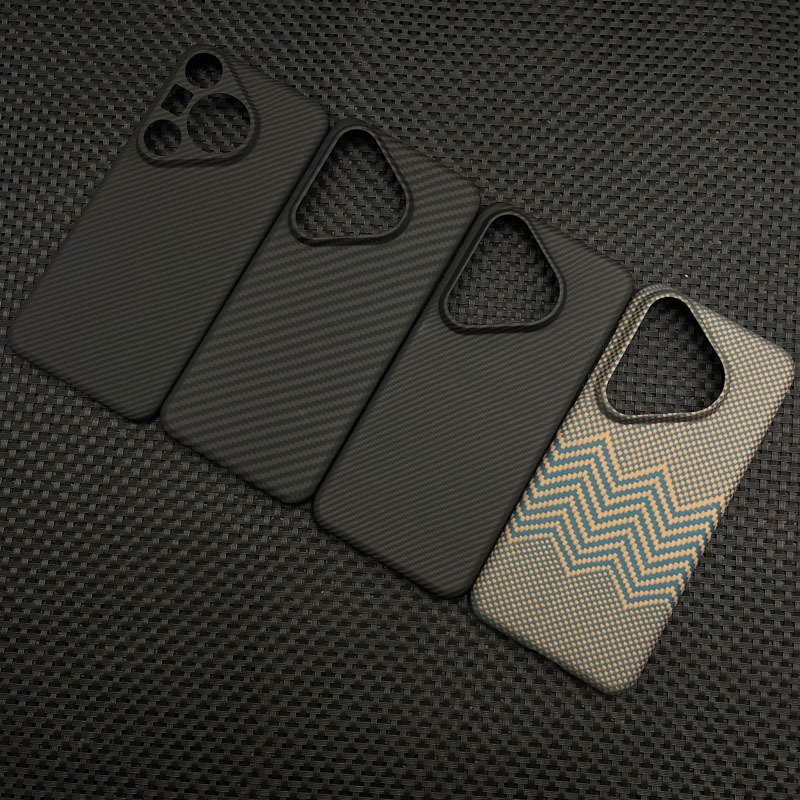
How Kevlar Cases Can Specifically Address The Pain Points of Clear Cases and Leather Cases?
In today’s mobile accessory market, transparent cases and leather cases hold a significant share. However, due to the inherent properties of their materials, they present numerous pain points for traditional distributors, retailers, and brands during the sales process.
Pain Points for Transparent Cases:
- Yellowing and Aging: This is the most common and frustrating issue with transparent cases. UV exposure, daily use, and the inherent properties of the material cause them to yellow and discolor relatively quickly, significantly impacting aesthetics. For B2B clients focused on product lifecycle and customer satisfaction, this is a major concern, as frequent returns or customer complaints increase their operational costs.
- Limited Protection: Most transparent cases prioritize a slim profile, offering relatively weak protection against drops, especially from heights or against sharp objects.
- Poor Hand Feel: Some transparent case materials easily attract fingerprints and can feel slippery, affecting the user experience.
- Lack of Differentiation: The market is saturated with similar transparent case products, making it difficult for B2B clients to stand out from competitors and often leading to compressed profit margins.
- Packaging and Shipping Challenges: Large quantities of transparent cases are prone to scratches during transit, requiring specialized packaging that increases shipping costs and the risk of damage.
Pain Points for Leather Cases:
- Bulky and Voluminous: Leather cases typically add significant thickness and weight to a phone, which is a drawback for users who prefer a slim experience.
- Heat Dissipation Issues: Some leather cases can impede phone cooling, especially during extended use or gaming, potentially leading to overheating.
- Prone to Wear and Tear: While leather feels premium, prolonged use can lead to scuffs, scratches, or even cracks, affecting aesthetics and lifespan.
- Relatively High Price: Compared to silicone or transparent cases, leather cases usually have a higher cost. This means higher procurement costs for B2B clients and a higher retail price, which might impact sales volume.
- Limited Functionality: Many leather cases offer basic protection but lack additional features like kickstands or sufficient card slots to meet all user needs.
- Inconvenient Cleaning and Maintenance: Leather materials require specific cleaning and care methods, which are less convenient than materials like silicone.
How Kevlar Cases Can Specifically Address These Pain Points?
Kevlar material, known for its exceptional strength and lightweight properties, offers unique advantages in phone protection, effectively addressing the pain points mentioned above:
Solutions for Transparent Case Pain Points:
- Ultimate Thinness and Durability: Kevlar’s hallmark is being “light as a feather, strong as steel.” Compared to transparent cases, Kevlar cases can offer superior impact resistance and scratch protection while remaining incredibly thin, completely solving the problem of insufficient protection found in ordinary transparent cases.
- No Yellowing, Long-Lasting Freshness: Unlike TPU transparent cases that yellow from oxidation or UV exposure, Kevlar material itself does not yellow. This allows it to maintain its original appearance for a long time, addressing the core pain point of transparent cases yellowing and aging, and reducing customer after-sales costs.
- Premium Texture and Differentiation: Kevlar’s unique woven texture provides a high-end, tech-savvy visual and tactile experience. This allows B2B clients to offer differentiated premium products, avoiding homogenous competition and enhancing brand image and profit margins.
- Comfortable Hand Feel, Anti-Slip: Kevlar material typically offers good grip, providing a comfortable and anti-slip hand feel, solving the potential slippery sensation of transparent cases.
Solutions for Leather Case Pain Points:
- Extremely Thin, Bid Farewell to Bulk: Kevlar protective cases can be made incredibly thin, far less bulky and heavy than traditional leather cases. This perfectly solves the problem of bulky and voluminous leather cases, meeting user demands for a slim experience.
- Excellent Heat Dissipation: Kevlar material itself does not retain heat, and its unique structure aids in heat dissipation. Compared to tightly wrapped leather cases, Kevlar cases have minimal impact on phone cooling, preventing overheating.
- Superior Wear Resistance, Long-Lasting: Kevlar fibers have tensile strength five times that of steel, offering extremely high wear and impact resistance. This means Kevlar cases can significantly extend product lifespan, solving the pain point of leather cases being prone to wear and tear, reducing user replacement frequency and B2B client complaints.
- High-End Positioning, Premium Potential: The uniqueness and high-performance attributes of Kevlar material give it higher market value. B2B clients can position it as a premium product line, achieving higher profit margins and brand premium, offsetting potentially higher initial procurement costs.
- Easy to Clean and Maintain: Kevlar material typically requires no special maintenance, and everyday cleaning is relatively simple.
In summary, Kevlar protective cases, with their lightweight, durable, non-yellowing, excellent heat dissipation, long-lasting, and unique premium texture characteristics, can precisely target the core pain points of transparent cases (yellowing, poor protection, lack of differentiation) and leather cases (bulkiness, wear and tear, poor heat dissipation). For international B2B businesses, offering Kevlar protective cases not only enhances product competitiveness but also helps clients improve user satisfaction, reduce after-sales costs, and open up new high-end markets, thereby achieving greater business value.